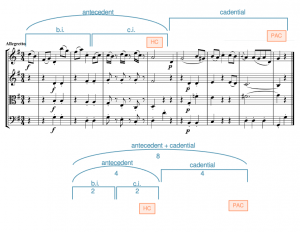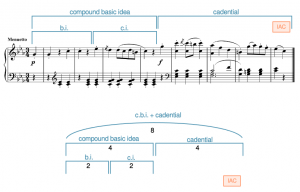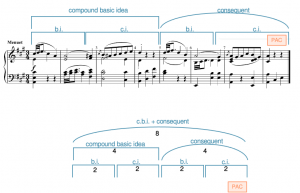III. Form
Hybrid Phrase-Level Forms
John Peterson
Key Takeaways
- A hybrid form combines the beginning of one archetype with the ending from another.
- Possible beginnings are antecedents, presentations, or compound basic ideas.
- Possible endings are consequents, continuations, or cadential endings.
- Although any beginning could be combined with any ending, some pairings are more common than others (see Example 7).
What’s a hybrid form?
In The Phrase, Archetypes and Unique Forms, we looked at two phrase-level formal archetypes: the sentence and the period.
We found that these forms divide into two parts. A sentence divides into two subphrases: a presentation and a continuation. A period divides into two phrases: an antecedent and a consequent.
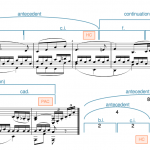
A hybrid form occurs when the beginning of one archetype is paired with the ending from another archetype. In Example 1, an antecedent is followed by a continuation.
- How do we know the first part is an antecedent rather than a presentation?
- It ends with a weaker cadence, whereas presentations don’t end with cadences.
- It has a basic idea followed by a contrasting idea, whereas presentations have a basic idea followed by a repetition of the basic idea.
- How do we know the second part is a continuation rather than a consequent?
- Rather than beginning as consequents do with a basic idea, it begins with fragmentation, which is characteristic of continuations.
- It begins with a feeling of instability created by the dominant that continues after the half cadence, rather than the stability that’s typical of a consequent’s beginning.
So far, we know two beginnings (presentation and antecedent) and two endings (continuation and consequent), but there’s actually one more possible beginning (compound basic idea) and one more possible ending (cadential). Below, we’ll outline these new beginnings and endings and provide ways to help distinguish between them.
Beginnings
New: The Compound Basic Idea (c.b.i.)
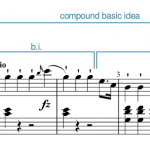
A compound basic idea (c.b.i.) is an antecedent without a cadence, as seen in Example 2.[1]
- How is Example 2 like an antecedent?
- It contains a basic idea followed by a contrasting idea.
- How is Example 2 different from an antecedent?
- It doesn’t end with a cadence. Notice how the bass sits on G across mm. 3–4: although the melody comes to a point of rest, the lack of harmonic motion in the bass evades the half cadence (HC) that might have appeared there.
Summary: The Three Beginning Types
The three beginnings that appear in hybrid phrase-level forms are antecedent, compound basic idea, and presentation. Example 3 provides a summary of the characteristics that differentiate each of these beginnings.
| Beginning | Ends with cadence? | First idea | Second idea |
|---|---|---|---|
| antecedent | Yes | b.i. | c.i. |
| compound basic idea | No | b.i. | c.i. |
| presentation | No | b.i. | b.i. |
Example 3. Characteristics that differentiate beginnings.
Endings
New: Cadential (cad.)
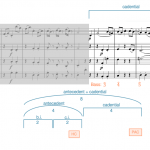
A cadential (cad.) ending harmonizes a particular bass pattern (demonstrated in Example 4).[2]
The core bass pattern is mi–fa–sol–do [latex](\hat3-\hat4-\hat5-\hat1)[/latex].[3] The common harmonization of each of these notes is:
- mi [latex](\hat3)[/latex]: I6
- fa [latex](\hat4)[/latex]: ii6 or IV
- sol [latex](\hat5)[/latex]: V(7) (often elaborated with cadential [latex]^6_4[/latex])
- do [latex](\hat1)[/latex]: I
This core mi–fa–sol–do [latex](\hat3-\hat4-\hat5-\hat1)[/latex] bass line may be embellished. A common embellishment is to tonicize the dominant by adding fi before sol ([latex](\uparrow\hat4-\hat5)[/latex], making the bass line mi–fa–fi–sol–do [latex](\hat3-\hat4-\uparrow\hat4-\hat5-\hat1)[/latex].
The clearest cadential endings are four measures long with one bass note per measure.
Summary: The Three Ending Types
The three endings that appear in hybrid phrase-level forms are consequent, continuation, and cadential. Example 5 provides a summary of the characteristics that differentiate each of these endings.
| Ending | Cadence | Bass | Ideas |
|---|---|---|---|
| Consequent | PAC/IAC. Not HC. | Varies | b.i. + c.i. |
| Continuation | HC, IAC, or PAC. | Varies | vary, but often divided 1+1+2 or 2+2 |
| Cadential | PAC/IAC. Not HC. | Mi−fa−sol−do [latex](\hat3−\hat4−\hat5−\hat1)[/latex] or an elaboration of that line. | Either 2+2 or indivisible. Never features fragmentation. |
Example 5. Characteristics that differentiate endings.
Hybrid Possibilities and Examples
The three possible beginnings and three possible endings are shown in Example 6. While any beginning on the left could be paired with any ending on the right, Example 7 shows that there are some pairings that are more common than others.
Below, we provide examples for all hybrids in the “slightly less common” and “occasional” categories (Examples 8–12). We already provided examples of the period and sentence in The Phrase, Archetypes, and Unique Forms.
The examples we provide in this chapter are all eight-measure archetypes, but as we show in the next chapter, these forms can be any length.
| Beginnings | Endings |
|---|---|
| Antecedent Compound basic idea (c.b.i.) Presentation |
Consequent Continuation Cadential |
Example 6. Possible beginnings and endings. Any beginning on the left can theoretically pair with any ending on the right.
| Form | Degree of commonality |
|---|---|
| pres.+cont. (sentence) ant.+cons. (period) |
very common |
| c.b.i.+cons. c.b.i.+cont. ant.+cont. |
slightly less common |
| c.b.i.+cad. ant.+cad. |
occasional |
| pres.+cad. pres.+cons. |
rare or non-existent |
Example 7. Pairings of beginnings and endings sorted by degree of commonality.
- Example 8. An antecedent + continuation in Beethoven, Piano Sonata Op. 13, II, mm. 1–8 (0:00–0:31).
- Example 9. A compound basic idea + continuation in Haydn, Piano Sonata Hob. XVI:35, I, mm. 1–8 (0:00–0:10).
- Example 10. An antecedent + cadential in Haydn, String Quartet Op. 64, No. 4, II, mm. 1–8 (0:00–0:10).
- Example 11. A compound basic idea + cadential in Haydn, Symphony 95, III, mm. 1–8 (0:00–0:10).
- Example 12. A compound basic idea + consequent in Haydn, Symphony 97, III, mm. 1–8 (0:00–0:11).
Listening to Phrase-level Forms
With so many possibilities, it might seem overwhelming to try to sort through the various possibilities. Example 13 offers a suggested listening strategy that can help determine what kind of beginning and ending you’re hearing.
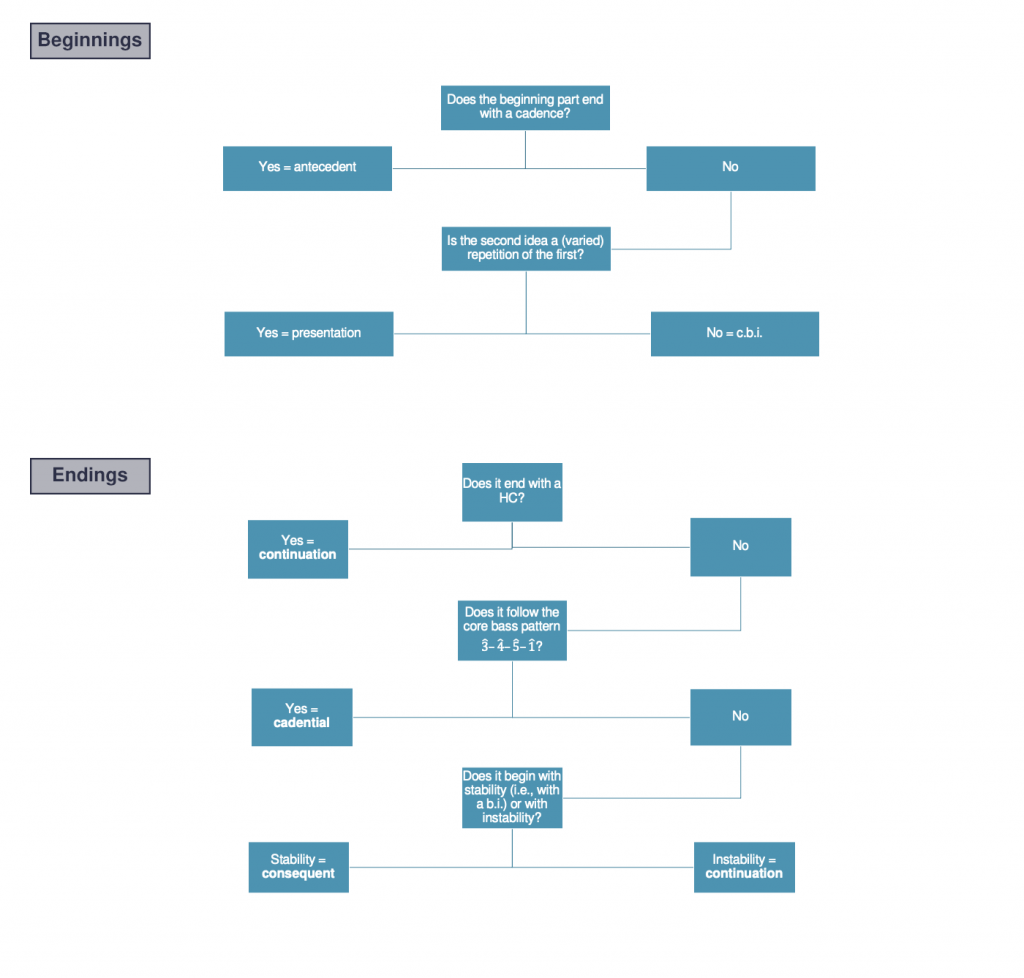
-
Caplin, William Earl. 2013. Analyzing Classical Form: An Approach for the Classroom. New York: Oxford University Press.
- Analyzing hybrid forms (.pdf, .docx). Provides excerpts and asks students to indicate which term best describes the first and second half of each. Optional harmonic analysis included. Worksheet playlist
- Analyzing forms with multiple possibilities (.pdf, .docx). Asks students to identify preferred and plausible alternative interpretations for several excerpts. Also includes band music. Worksheet playlist
- Composing phrase-level forms (.pdf, .docx). Asks students to compose a phrase-level form given a description. Provides a basic idea bank to give students a start.
Media Attributions
- Example_001_Ant+Cont © John Peterson and Megan Lavengood is licensed under a CC BY-SA (Attribution ShareAlike) license
- Example_002a_compound_basic_idea © John Peterson and Megan Lavengood is licensed under a CC BY-SA (Attribution ShareAlike) license
- Example_004a_cadential © John Peterson and Megan Lavengood is licensed under a CC BY-SA (Attribution ShareAlike) license
- Example_013a_Listening_Diagram_Caplin © John Peterson and Megan Lavengood is licensed under a CC BY-SA (Attribution ShareAlike) license
- What is "compound" about the compound basic idea? It often functions as the basic idea of a large sentence, one that is sixteen measures in length, where the presentation is eight measures long and comprises two c.b.i. units. It's "compound" in the sense that these large basic ideas are themselves composed of two units: a b.i. and a c.i. ↵
- What is the difference between a cadential idea and cadential ending? The cadential idea comes at the end of a continuation, and essentially, the cadential ending is like the cadential idea being expanded to four measures and replacing the continuation. That means that "cadential" can occur at two formal levels: the idea level and the subphrase level. ↵
- This can also occur in minor, of course, as me–fa–sol–do [latex](\downarrow\hat3-\hat4-\hat5-\hat1)[/latex]. ↵
A phrase form that combines aspects of the sentence and the period into one phrase-level form.
A phrase consisting of a basic idea followed by a contrasting idea that ends with a weak cadence.
A subphrase consisting of a basic idea and its repetition. Presentations don't usually end with cadences.
A compound basic idea (c.b.i.) is an antecedent without a cadence. It consists of a basic idea followed by a contrasting idea.
A phrase consisting of a basic idea followed by a contrasting idea that ends with a strong cadence. It usually forms the second half of a phrase-level form.
A subphrase that features a mix of any of the following: fragmentation, increase in harmonic rhythm, increase in surface rhythm, or sequences. Continuations end with a cadence and are usually found in the second half of a theme.
One of the three common ending types. Its distinguishing characteristic is its bass line: mi–fa–sol–do (3̂–4̂–5̂–1̂), which may be elaborated with chromaticism.
Phrases that are "archetypal" or that follow an archetype are related to the sentence, the period, or one of the hybrid phrase-level forms.
A special kind of phrase consisting of a presentation and a continuation.
A phrase-level form that consists of two phrases: an antecedent and a consequent.
A unit in some phrase-level forms that is one level smaller than a phrase, but one level larger than an idea.
A relatively complete musical thought that exhibits trajectory toward a goal (often a cadence).
Basic ideas are short units that are typically associated with beginnings. They don't usually end with cadences, and they often establish tonic. They are the first units we hear in a presentation, an antecedent, a consequent, and a compound basic idea.
A small unit that contrasts with the material that came immediately before it, usually in terms of contour. It's featured in the antecedent and the compound basic idea.
Making unit sizes smaller than the previously established size. For example, if units had previously been two measures long, fragments might be one measure long.
A kind of inconclusive cadence that occurs when a phrase ends on V. Occasionally, particularly in Romantic music, the final chord of a half cadence will be V⁷.
A core bass pattern is the basic series of notes that defines a common progression. This series of notes may be embellished with other, less important notes, but the pattern is still recognizable because the basic series is still present.
The process by which a non-tonic triad is made to sound like a temporary tonic. It involves the use of secondary dominant or leading-tone chords.


